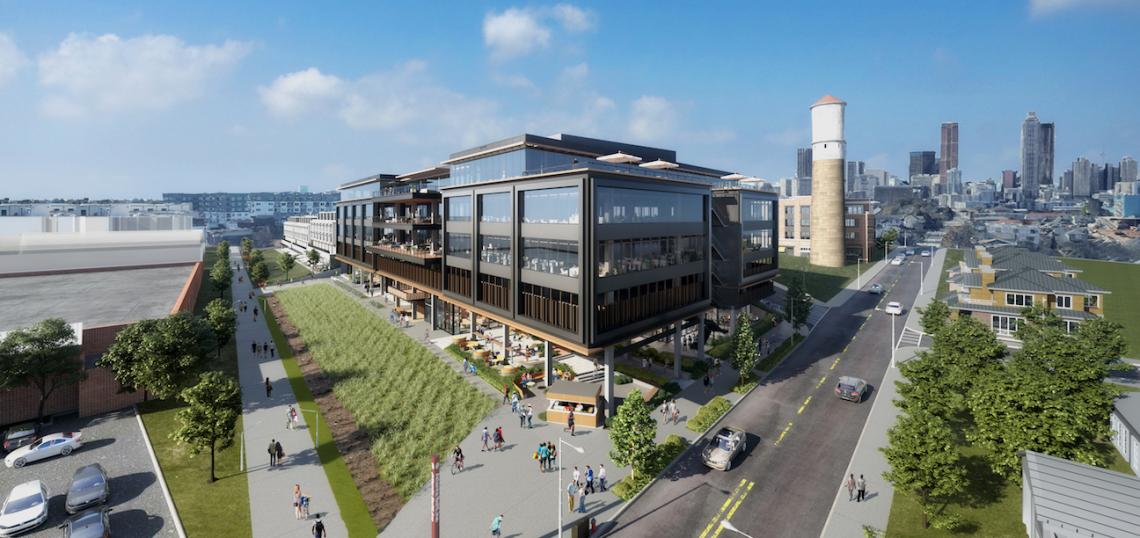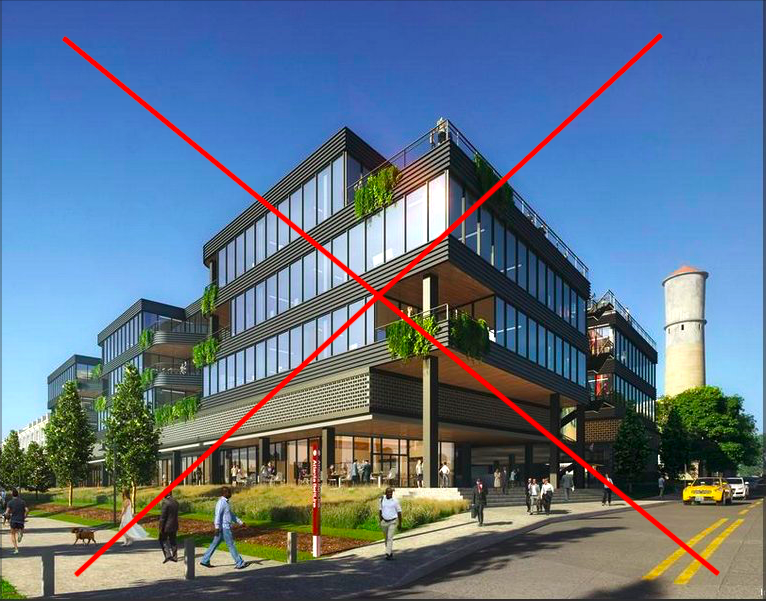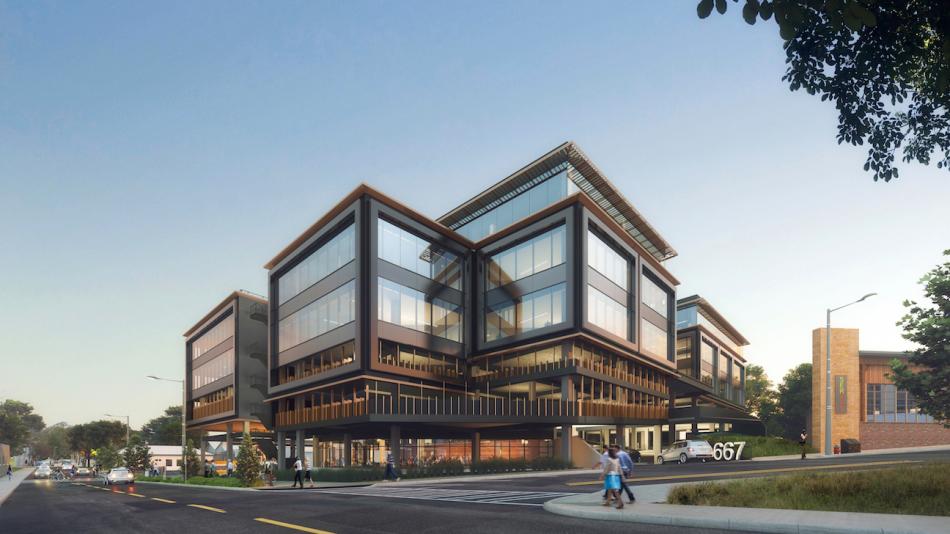Big ideas have been floated for a shabby corner of the Old Fourth Ward, where Irwin Street meets the Atlanta BeltLine, since Barrack Obama was in office. But all indications are that Portman Holdings’ latest plans will stick—and start happening soon.
That’s not to say the general vision wasn’t blown up and redrawn in recent months.
Mike Greene, Portman’s vice president of development, spoke candidly with Urbanize Atlanta this week about those changes and why aspects of the six-story, Class A office project could feel like an approachable, outdoor living room for the general public. He shared the latest Portman Architects-designed renderings that lend the best glimpses yet of what the $85-million venture should look like, inside and out.
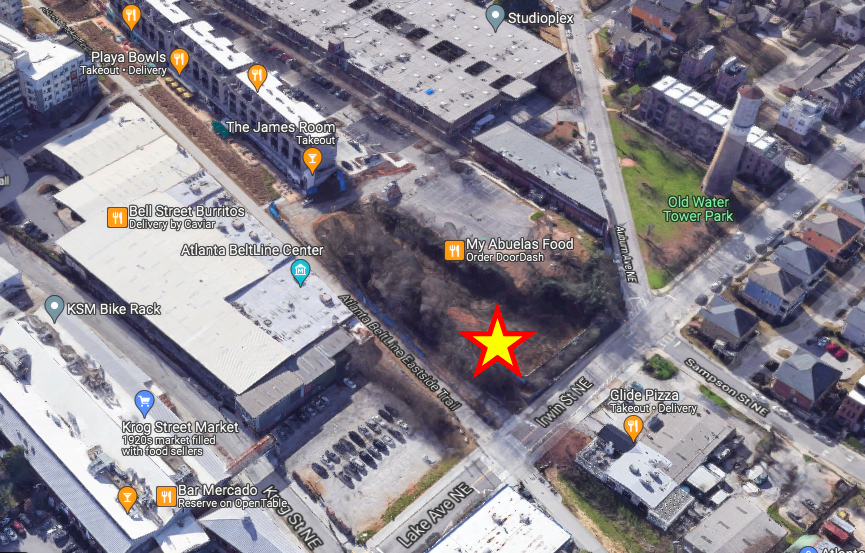 The site is across the BeltLine's Eastside Trail from Krog Street Market's ongoing expansion, as part of the broader Krog District. Google Maps
The site is across the BeltLine's Eastside Trail from Krog Street Market's ongoing expansion, as part of the broader Krog District. Google Maps
Another group had tried to put plans in motion for a hotel on the 1.3-acre site at the southwest corner of the BeltLine and Irwin Street six years ago, but that ultimately sputtered. Portman bought property for $5.5 million in 2018 and also initially envisioned building a boutique lodge. COVID-19 crushed that idea.
Totaling roughly 130,000 square feet of interior space, the 667 Auburn Avenue project is part of the StudioPlex Master Development. The Atlanta BeltLine Development Review Committee approved its variations and overall scheme earlier this summer.
Greene explains how the project is now designed to be approached from multiple angles, and why it’s hardly a staid office building with a security guard and banks of elevators. The interview, in FAQ format below, is condensed for clarity and length.
Why change the initial office plans?
“It didn’t quite hit the right notes for me,” says Greene. “It had a very midcentury, linear aesthetic with heavy black banding around the building. I was very concerned that if it went through [value engineering] in order to get the pricing in line, the building could start to look very much like some kind of 1980s office building. I was so concerned about it, we went back the drawing board with Portman Architects and started to pull it apart again.”
What’s changed in the new scheme?
The building will retain its large open floorplans, as tech companies seem to prefer, and generally the same shape, but a greater emphasis was put on large, consolidated outdoor spaces at ground level and above. Roughly 12,000 square feet of balconies are planned, with some of them cantilevering toward the BeltLine.
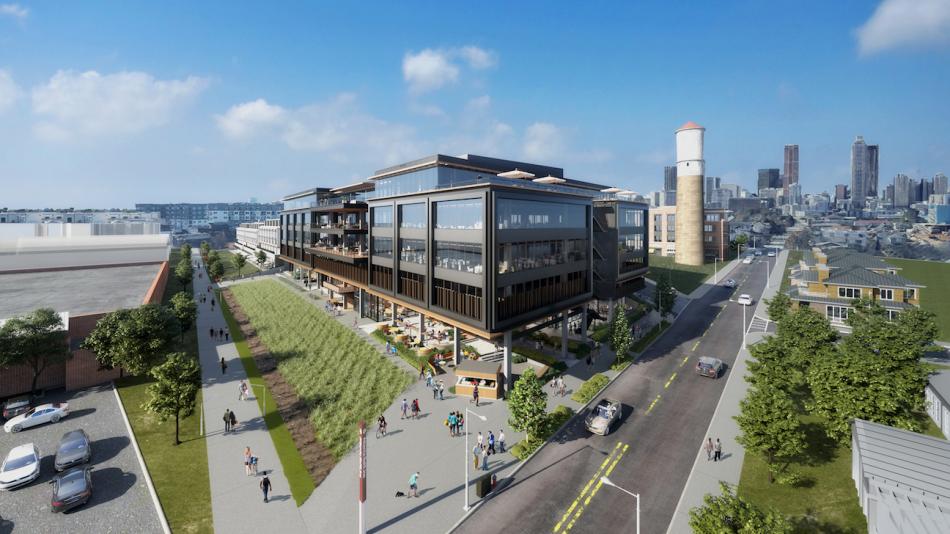 Plans call for installing BeltLine rail service in the grassy area between the Eastside Trail and Portman's project. Courtesy of Portman Architects/Portman Holdings
Plans call for installing BeltLine rail service in the grassy area between the Eastside Trail and Portman's project. Courtesy of Portman Architects/Portman Holdings
“We still kept the building modern-ish,” says Greene. “We didn’t want to try to copy the historic feel of the neighborhood. We didn’t want it to look like a brick warehouse, but also not like a spaceship that landed in the middle of a brick warehouse.”
With a huge porch?
For passersby, the project’s defining feature could be a large public porch space with multiple seating areas and about 7,000 square feet of retail space, plus a detached kiosk for grabbing drinks. (Think the courtyard at Atlanta Dairies, but more linear and raised up a few feet from the BeltLine.)
Expect a restaurant, coffee shop, and possibly two smaller retail spaces, all designed by Atlanta-based Square Feet Studio, with landscaping by Kimley-Horn.
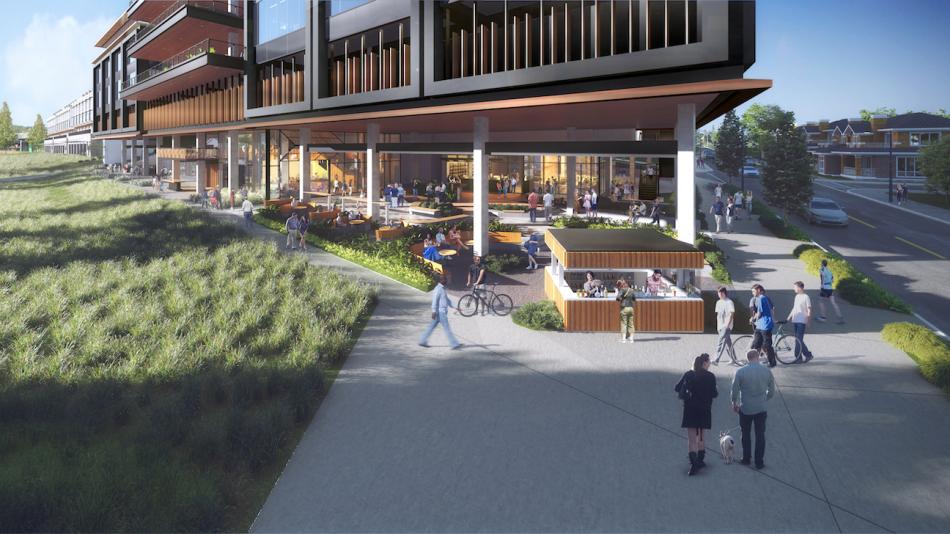 A plaza connecting the BeltLine to a planned kiosk and porch space. Courtesy of Portman Architects/Portman Holdings
A plaza connecting the BeltLine to a planned kiosk and porch space. Courtesy of Portman Architects/Portman Holdings
“None of the retailers will be able to lay claim to this porch, but they’ll all be able to use it,” says Greene. “It should be activated in three ways, in a triangular shape, so that when folks are sitting on the porch, it feels like a place to be.”
Plans also call for the restaurants and coffee shop to have walk-up windows.
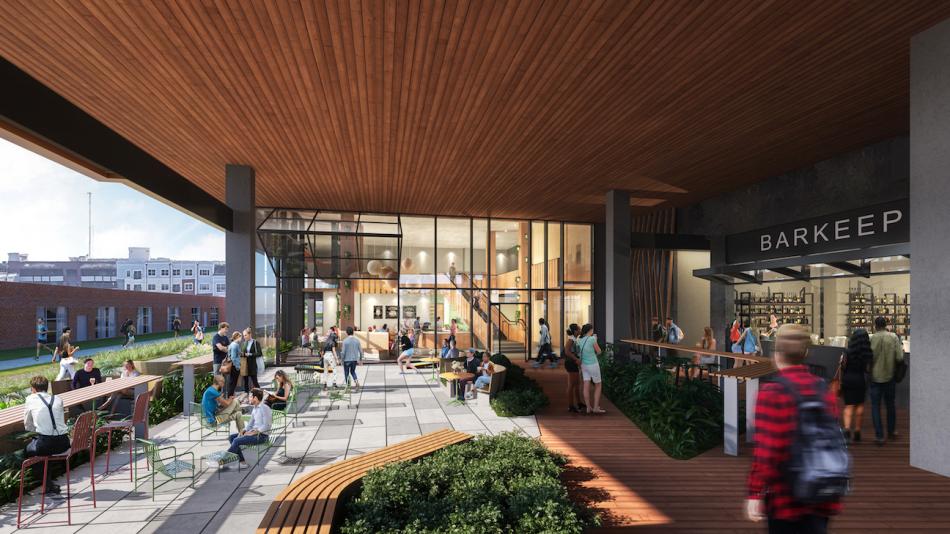 Public spaces that would be shared by all retailers at 667 Auburn Avenue. Courtesy of Portman Architects/Portman Holdings
Public spaces that would be shared by all retailers at 667 Auburn Avenue. Courtesy of Portman Architects/Portman Holdings
So there's more parking now?
The redesigned project calls for 206 parking spaces, or about 1.5 spaces per 1,000 square feet, which Greene calls the least amount possible without endangering the project’s financing and eventual leasing viability.
“That’s still modest, but I didn’t like anything about it,” says Greene. “We weren’t going to be able to lease it successfully with that little amount of parking [before], even with the BeltLine. I’m sorry, tenants still expect parking. As much as I despise parking, it just has to happen. Even with [206 spaces], the investment community was still nervous about that; it was a major point folks were concerned about. The last thing I want to do is build parking spaces—it’s nothing but thrown-away money.”
And active steps?
On the southern edge of the property is what Greene calls a “depressing little hill left over from the original development.” Asana Partners, owner of SPX Alley, has agreed to let Portman construct what Greene calls “a meandering staircase or vertical terrace” with gardens and multiple seating areas.
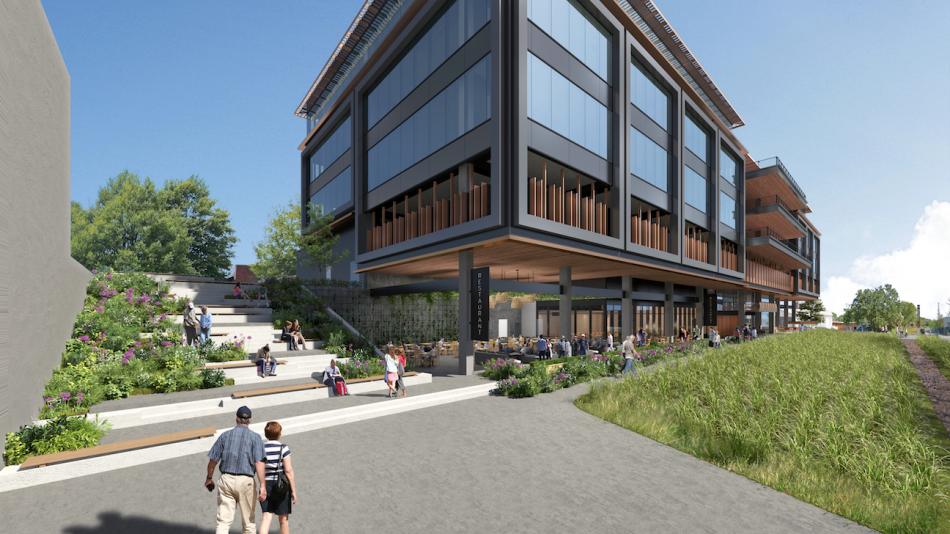 A wide BeltLine connection planned between the vertical terrace and Stove Works complex. Courtesy of Portman Architects/Portman Holdings
A wide BeltLine connection planned between the vertical terrace and Stove Works complex. Courtesy of Portman Architects/Portman Holdings
“We’re trying to make it as much of a vertical park, rather than a staircase, as possible,” he says. “Think Spanish Steps-style, with multiple nooks where you can sit and chat with a friend on this stadium seating over the BeltLine.”
How will BeltLine-goers reach the property?
Typical four or five-foot sidewalks around the BeltLine used to reach nearby residences and businesses aren’t sufficient, especially when planned light rail uses the BeltLine corridor to travel through Old Fourth Ward, Greene says. The BeltLine gave permission to build much wider crossings at the north and south edges of the office project.
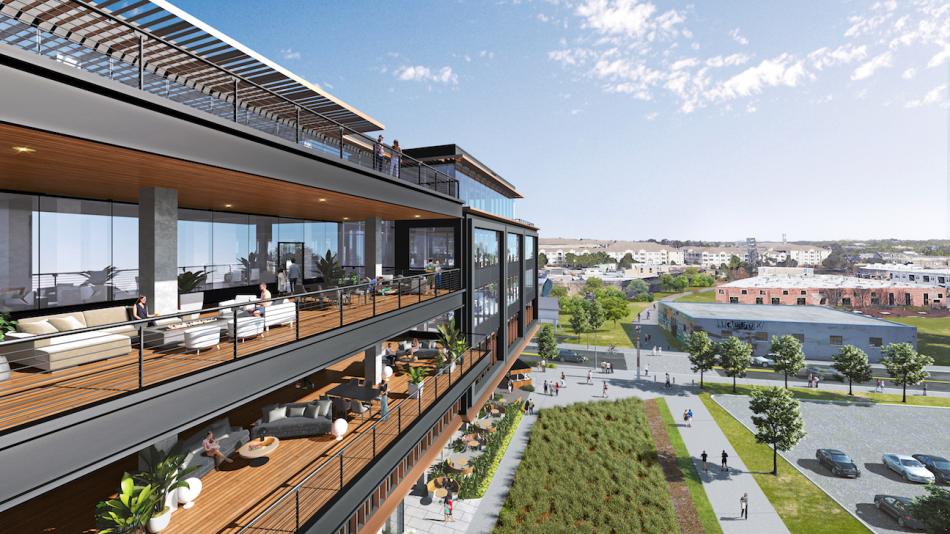 How multiple rows of office balconies will overlook the Eastside Trail. Courtesy of Portman Architects/Portman Holdings
How multiple rows of office balconies will overlook the Eastside Trail. Courtesy of Portman Architects/Portman Holdings
“The one on Irwin Street will be 15 or 17-feet wide,” like a little plaza dotted with errant-driver-discouraging planters, to alleviate pedestrian congestion, says Green. “It helps with breathing room.”
In front of the staircase will be another wide connection, allowing pedestrians to cross from the Stove Works complex to the east side of the BeltLine near SPX Alley, where the train stop is tentatively planned.
What’s the scoop on bike parking?
Next to the lobby, 100 bike parking spaces with valet service for safekeeping are planned. The setup will be intentionally visible, Greene says, and intended to make a statement.
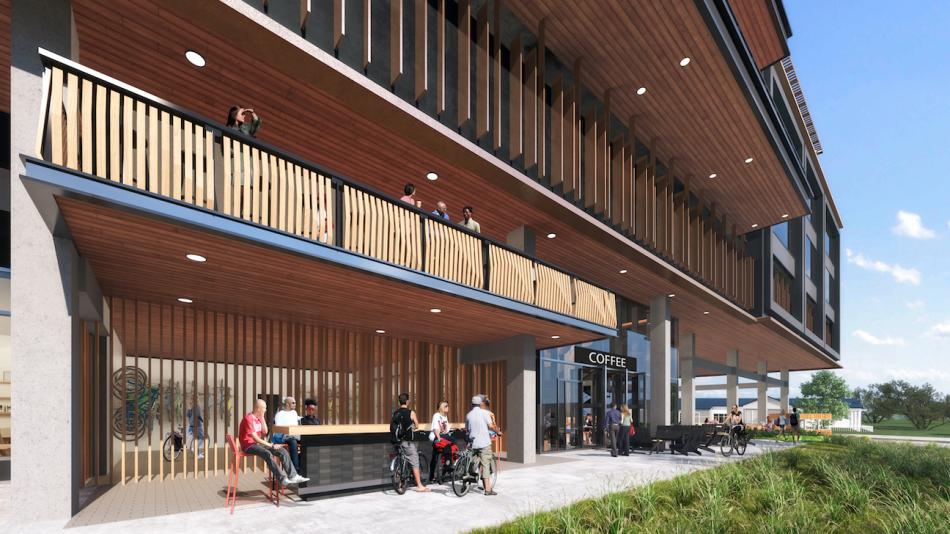 A glimpse into planned bike storage with valet service. Courtesy of Portman Architects/Portman Holdings
A glimpse into planned bike storage with valet service. Courtesy of Portman Architects/Portman Holdings
“Instead of taking the bike room and shoving it in the back somewhere, we thought to put it right next to the lobby, next to the BeltLine. We got some pushback on that, because we’re taking up some pretty ridiculous real estate for this bike room,” says Greene. “But we want people to ride up. What I’m hoping is, if you come into the lobby or coffee shop, and you see these bikes hanging through the window, you’ll realize you could have easily biked to work today.”
Connected to the bike facilities will be six individual shower rooms for office employees. Another roughly 50 bike spaces are planned in the garage for overflow parking.
Any public art?
Two murals on the south side of the building will face the SPX Alley property, and a larger four-story painting will lord over Irwin Street on the north side.
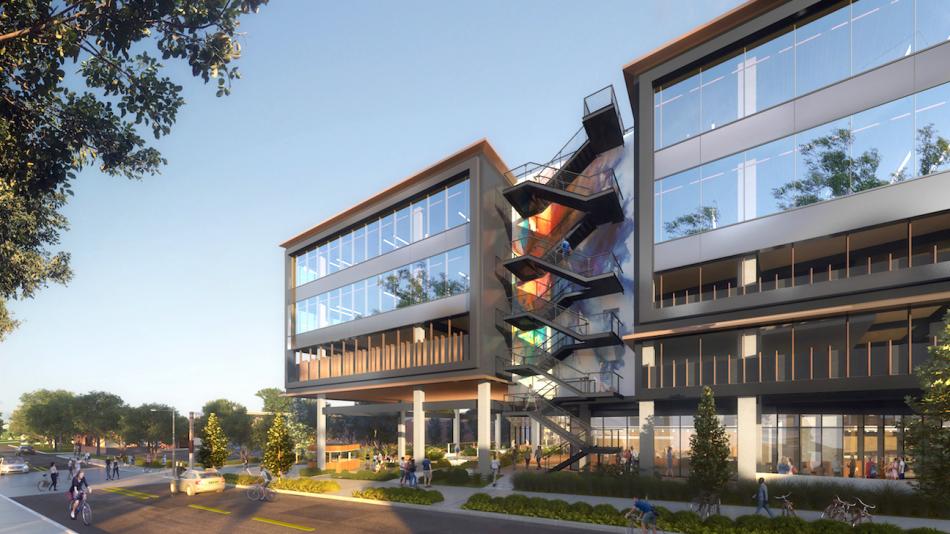 Where a four-story mural would be installed along Irwin. Courtesy of Portman Architects/Portman Holdings
Where a four-story mural would be installed along Irwin. Courtesy of Portman Architects/Portman Holdings
“We’re also talking to this group out of New York where you do these revolving sculpture pieces of exterior art, that allows artists to exhibit pieces on a rotating basis across the country instead of storing them away,” says Greene. “The artists love it, because it’s actually cheaper to display the pieces than keep them in storage. And I love it, because we’d get something different all the time, and you get some pretty famous artists you otherwise probably wouldn’t be able to afford.”
The rotating sculptures would stand on the connector between Stove Works, the BeltLine, and the Portman property’s steps.
Is there a project name?
Not yet. “I like historical references,” says Greene, “so I was trying to convince the team that we should reference the old Southern Iron and Equipment Company that used to be on site. But that could be vetoed.”
What’s the timeline?
A Special Administrative Permit has been approved, and a land-disturbance permit is expected to be green-lighted by the city in November. Barring permitting delays, Portman plans to break ground in December, or January at latest.
Greene says it’ll take 16 months to build.
• Before/after: A decade of changes in Atlanta's Old Fourth Ward (Urbanize Atlanta)





